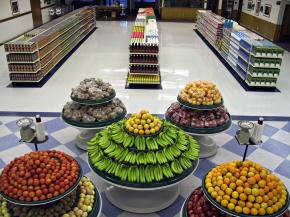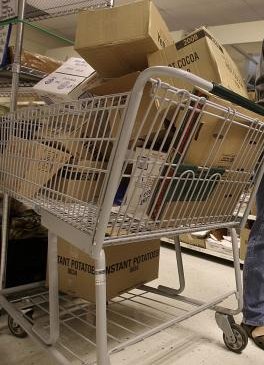Difference between revisions of "Bishop's Storehouses"
| Line 1: | Line 1: | ||
[[Image:Bishops_Storehouse.jpg|left|frame|Inside a Bishop's Storehouse run by the Church of Jesus Christ]] | [[Image:Bishops_Storehouse.jpg|left|frame|Inside a Bishop's Storehouse run by the Church of Jesus Christ]] | ||
| − | Since the early days of [http://comeuntochrist.org The Church of Jesus Christ of Latter-day Saints]in the 1800s, '''Bishop's Storehouses''' have been a part of the Church. However, up until the 1930s, these storehouses were maintained at the local congregational level only. In [[1936]], the Church announced what is now known as the [[Church Welfare Program]], which is a worldwide program within the Church. This program includes the program known as Bishop's Storehouses. | + | Since the early days of [http://comeuntochrist.org The Church of Jesus Christ of Latter-day Saints]in the 1800s, '''Bishop's Storehouses''' have been a part of the Church. However, up until the 1930s, these storehouses were maintained at the local congregational level only. In [[1936]], the Church announced what is now known as the [[Church Welfare Program|Church Welfare and Self-Reliance Program]], which is a worldwide program within the Church. This program includes the program known as Bishop's Storehouses. |
A Bishop's Storehouse is best described as a supermarket without the cash registers. The storehouse is purposely made to appear like a supermarket, so people going there feel like they are in a regular supermarket. The people who shop here are in need of food; for example, someone may be unemployed and have no money coming in to buy the basic necessities of life. In addition to food, storehouses carry jackets and jeans, towels and sheets. It is up to the [[Bishop]] in each Latter-day Saint [[ward]] (congregation) to determine if an individual qualifies for food from the Bishop's Storehouse. Although this program is mainly for Church members, it is possible for a non-member to obtain help from a Bishop's Storehouse, if the Bishop deems this appropriate. Also, in times of disaster, such as Hurricane Katrina, larger Bishop's Storehouses known as Regional Bishop's Storehouses were opened to supply victims of Hurricane Katrina with food and other items. Many of the people helped at this time were not Latter-day Saints. | A Bishop's Storehouse is best described as a supermarket without the cash registers. The storehouse is purposely made to appear like a supermarket, so people going there feel like they are in a regular supermarket. The people who shop here are in need of food; for example, someone may be unemployed and have no money coming in to buy the basic necessities of life. In addition to food, storehouses carry jackets and jeans, towels and sheets. It is up to the [[Bishop]] in each Latter-day Saint [[ward]] (congregation) to determine if an individual qualifies for food from the Bishop's Storehouse. Although this program is mainly for Church members, it is possible for a non-member to obtain help from a Bishop's Storehouse, if the Bishop deems this appropriate. Also, in times of disaster, such as Hurricane Katrina, larger Bishop's Storehouses known as Regional Bishop's Storehouses were opened to supply victims of Hurricane Katrina with food and other items. Many of the people helped at this time were not Latter-day Saints. | ||
Revision as of 14:18, 12 February 2024
Since the early days of The Church of Jesus Christ of Latter-day Saintsin the 1800s, Bishop's Storehouses have been a part of the Church. However, up until the 1930s, these storehouses were maintained at the local congregational level only. In 1936, the Church announced what is now known as the Church Welfare and Self-Reliance Program, which is a worldwide program within the Church. This program includes the program known as Bishop's Storehouses.
A Bishop's Storehouse is best described as a supermarket without the cash registers. The storehouse is purposely made to appear like a supermarket, so people going there feel like they are in a regular supermarket. The people who shop here are in need of food; for example, someone may be unemployed and have no money coming in to buy the basic necessities of life. In addition to food, storehouses carry jackets and jeans, towels and sheets. It is up to the Bishop in each Latter-day Saint ward (congregation) to determine if an individual qualifies for food from the Bishop's Storehouse. Although this program is mainly for Church members, it is possible for a non-member to obtain help from a Bishop's Storehouse, if the Bishop deems this appropriate. Also, in times of disaster, such as Hurricane Katrina, larger Bishop's Storehouses known as Regional Bishop's Storehouses were opened to supply victims of Hurricane Katrina with food and other items. Many of the people helped at this time were not Latter-day Saints.
In 2007 there were 108 Bishop's Storehouses in the United States and Canada. There are also 29 others in many countries in Latin America, where there are many members of the Church. Most are independent facilities, where the storehouse is the only entity in them, although a few have other Church services, such as Employment Resource Centers, sharing space with them. However, a new concept was unveiled in Layton, Utah, where all Church welfare services, including a Deseret Industries, an Employment Resource Center office, a Family Services office, Distribution Services store, and a couple other offices handling Church welfare services were all placed under one roof. This became the model for establishment of Bishop's Storehouse facilities in the future.
Where do the items come from that fill a Bishop's Storehouse? The food is grown on Church-owned farms. As an example, the Church grows apples on their farms in Ohio and Washington State. As of 2007, the Church owned 64 welfare farms.
How is the food transported from the farms to processing centers and canning? The Church transports the food by a fleet of Church-owned trucks known as Deseret Transportation. As of 2007, the Church owned 105 canneries in the United States, Canada, and Mexico. From these canneries, food items can be shipped worldwide. As an example, a cannery in Aurora, Colorado, cans a variety of different items. As of 2007, the Church owned 18 food processing facilities. One example of this is the Church-owned peanut butter facility in Houston, Texas.
How are Bishop's Storehouses financed? Every month, generally the first Sunday of the month, Church members are asked to fast for two meals. The amount of money that would be spent for those two meals is contributed to the Church. This is known as a fast offering. The money is used for needs in the local Latter-day Saint congregation and elsewhere. "Elsewhere" could mean almost anything, such as purchasing farmland in Argentina.
Where does the labor come from? There are few paid employees at the Bishop's Storehouses. Much of the labor comes from Church members who live in the vicinity of the Bishop's Storehouse. This labor is voluntary in nature. Because of the large amount of volunteer labor, the costs of maintaining the Bishop's Storehouses is low. Service missionaries and Young Service missionaries also serve there.
Is there anything expected of those who receive any food or other items from a Bishop's Storehouse? Generally yes. If a man is unemployed, he could be expected to do a service project, such as cutting the lawn at the local meetinghouse, if he was asked to do so by the Bishop. Permanent solutions are especially considered, not just temporary solutions. As an example, if a man were unemployed, the Church would help him find a job through the Church's Employment Resource Centers. Some of the people who are receiving food from a Bishop's Storehouse work at the Storehouse in exchange for the food and other items that they have received. Job training is received while working at the Bishop's Storehouse. Some people have used their skills they learned at the Bishop's Storehouse to find a job.
In areas of the world where there are no Bishop's Storehouses or when a Latter-day Saint congregation is located far away from a Bishop's Storehouse, food and other items would be purchased by the local congregation in order to help the needy. When not practical to have certain items produced from Church farms and processing centers sent to a Bishop's Storehouse, these items would be purchased locally and placed in the Bishop's Storehouse.
Sources
- Jim Wall, 2004 Church Almanac, published by Deseret Morning News in 2004 at Salt Lake City, Utah -Pages 125-144.
- Sarah Jane Weaver, LDS Church News, published week ending August 25, 2007 at Salt Lake City, Utah, by the Deseret Morning News Pages 9-11
The information contained in this article was current as of September 12, 2007.

